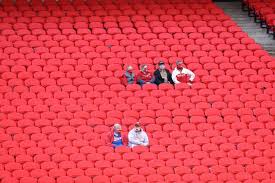In 2017, former Major League Soccer player turned ESPN soccer analyst Taylor Twellman launched into a rant about the United States men’s soccer team. After a shocking 2-1 loss to Trinidad and Tobago that kicked the U.S. out of the 2018 World Cup, Twellman, in the midst of a hair-raising diatribe on the institutional issues at U.S. Soccer, asked — and several times repeated — a very simple question:
“What are we doing?!”
The year is 2020, and in the sports world, Twellman’s question applies now more than ever.
The coronavirus is closing in on causing 200,000 deaths in the U.S., which has done an objectively terrible job containing the disease. In addition to COVID-19, there are also once-in-a-millennium wildfires ripping through the West Coast, and because of this, air quality in California, Oregon and Washington have plummeted, making it dangerous to go outside. Additionally, the country has faced a reckoning on systemic racism, but not everyone is with the times; a slimmed-down crowd at Arrowhead Stadium booed a pregame “moment of unity” to address these issues before the Texans and Chiefs faced off to start the 2020 NFL season.
It’s a weird world, and it may not be one that necessarily includes sports. But that doesn’t mean leagues aren’t trying to make it work, and in some cases, trying in truly insane ways.
Take college football, for example. Some of its conferences decided that fall sports just weren’t for them in 2020, such as the Patriot League, which includes Fordham’s football team. A couple of Power 5 conferences — the Big Ten and the PAC-12 — joined the fray in August, deeming football, which features more close contact and transmission than many other sports, unsafe in our current coronavirus climate.
That didn’t deter Big Ten players and coaches, though, many of whom came out publicly in favor of playing this year. The Big Ten also did itself no favors when it refused to explain its decision in detail publicly; this was in contrast to the PAC-12, which released the findings of its medical advisory committee to the public shortly after making its decision. One of these findings was a high propensity of myocarditis — heart inflammation that could lead to a heart attack or stroke — in athletes who tested positive for the disease.
However, after its chancellors voted 11-3 to postpone the fall sports season until the spring of 2021, it is now voting on a season that the Big ten could start as soon as Oct. 17. The main reason for this reversal is the presence of reliable, rapid testing, a breakthrough that wouldn’t necessarily stop an outbreak but could contain one before it infects half a team as it did at Clemson this summer.
That said, sports are not devoid of COVID-19-related risks even with rapid testing. The NBA and NHL have succeeded in using safe bubbles this summer and deserve credit for doing so, but Major League Baseball has aimlessly plowed through multiple outbreaks and other disasters. The latest self-induced baseball catastrophe took place in Seattle, where the Mariners and A’s played two games on Monday through a wildfire-induced haze at T-Mobile Park. The play that crystallized the bizarre decision-making that led to these games being played happened in the first game of the doubleheader, when A’s center fielder Ramon Laureano made a spectacular diving catch through smoke while wearing an N95 mask.
In July, when baseball first came back for “summer camp,” Nationals pitcher Sean Doolittle plainly laid out the stakes, calling sports “the reward of a functioning society.” Exactly what about our society is functioning right now? The United States has averaged roughly 1,000 deaths from COVID-19 per day since late-July, a full six months into the pandemic. Masks are political. Students in Boston are protesting guidelines that will require them to get the flu vaccine if they want to come back to school. And, worst of all, we can’t go anywhere freely without being concerned about catching a virus that could be fatal.
And yet, MLB and the NFL are plowing ahead without bubbles. Baseball commissioner Rob Manfred says he hopes fans can attend the league championship series and World Series from the league’s playoff bubbles in Arlington and San Diego, and only God knows why, considering this terrible idea would defy the entire point of a protective “bubble.” Moreover, baseball’s “bubble” is also deeply flawed because it will likely include ten different cities when the playoffs start at the end of September. A poorly-timed outbreak could wipe out a series, and possibly the entire endeavor. Even if it wouldn’t, a positive test or a group of them could push the playoffs into November, which baseball has shown a reluctance to do, given the worsening weather and a presidential election that is likely to captivate the nation but unlikely to be decided on Nov. 3. And the Big Ten is plowing along too, with a season starting in just a few weeks despite the risks its unpaid student-athletes will face.
No, I am not against sports being played in 2020. In some cases, we’ve seen it done safely. But, as I’ve said before, we need to ensure games happen safely, and leagues can’t afford to make unforced errors, whether those be allowing fans in stadiums or playing through outbreaks or natural disasters.
So as for Twellman’s question? Well, I don’t know what we’re doing, and I’m not sure it’s good.





